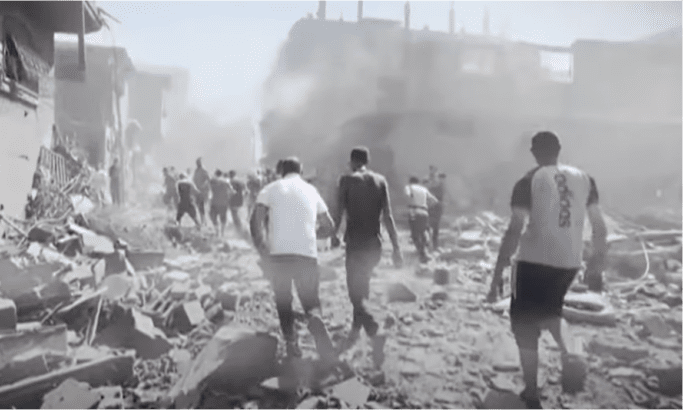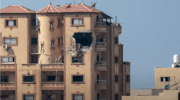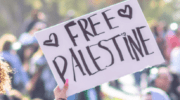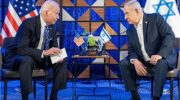The Israeli massacre in Gaza’s Nuseirat camp killed over 270 Palestinians and injured many more. Survivors say the horrors they witnessed will stay with them for the rest of their lives.
by Tareq S. Hajjaj, reposted from Mondoweiss
The Israeli massacre in the Nuseirat camp to retrieve four Israeli prisoners held by resistance factions in the Gaza Strip started at 11:00 in the morning on June 8. Although the scenes of Palestinians running for safety may have seemed sadly familiar, this invasion was different from others that have been carried out across the Gaza Strip.
This time, the Israeli military wore civilian clothes, rode in Palestinian cars, and moved among the people in disguise. There were no warnings to evacuate, or orders from the army to move elsewhere, and people were surprised by the Israeli special forces and tanks. A large number of special forces hidden among the people only revealed themselves once the deadly operation began as other special forces stormed the area traveling in cars loaded with luggage, the same luggage that the displaced people carry with them, such as mattresses, pillows, blankets, and bags. When the Palestinians detected them, the soldiers quickly called for support, and helicopters, fighter planes, artillery, and tanks descended. Reconnaissance aircraft and foot solders then began committing massacres against the civilian population.
The intensity of shelling and gunfire soon warned the residents that a massacre was unfolding. They left their homes and took to the streets running in search of safety, which could not be found.
The Israeli operation killed 274 Palestinians, including 64 children, and injured 689 Palestinians in total. “Some of the bodies that arrived at the hospital were body parts, as well as dismembered bodies,” the Gaza Ministry of Health reported when announcing the casualty numbers.
As the world celebrates the “rescue” of four Israeli hostages from the Gaza Strip, and the media focuses on their lives, freedom, and the happiness of their families there is barely a mention of the number of Palestinian casualties or consideration that each of those killed are also leaving behind a bereaved family.
Issam Hajjaj, 27, survived the massacre and spoke to Mondoweiss. “We were running away from bombing and killing. In all directions, there was either bombing, an Israeli tank, or Israeli gunmen shooting at anyone in their path,” he explained. “While we were running away from death, I saw dismembered bodies on the road as a result of the bombing, and I saw those who left their loved ones under the rubble and fled to save the rest of the family.”
“We did not know from which direction death would come for us.”
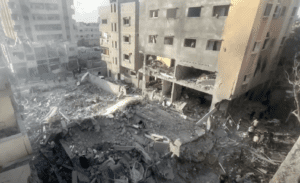
Anatomy of a massacre
Following the attack the Israeli army announced that the element of surprise had been crucial. This is why the military operation took place during daylight hours and in a densely populated area. This is also why there was such a high number of Palestinian casualties.
Hajjaj says that within minutes of the invasion starting, Israeli forces surrounded the targeted location from all sides and did not leave any route for people to escape except one road, Al-Zuhur Road connecting Nuseirat and Deir Al-Balah. However, just at the same time that the Nuseirat massacre took place, people near Al-Aqsa Martyrs Hospital in Deir Al-Balah were fleeing to Nuseirat, and people were using this street to arrive. The intense crowding in the street during the continuous bombing spread panic, and bodies soon began to fly as a result of the direct targeting of everything in that area.
“During our escape, we saw bodies being loaded into cars heading to Al-Aqsa Martyrs Hospital. Women were screaming in the streets, and children were crying and screaming,” Hajjaj recounted. “I saw a family that was fleeing together. A shell fell on the father and killed him in front of his wife and young daughter. After the mother got up and carried her daughter, she discovered that her husband was killed; she left him on the ground and fled to save her daughter and herself.”
Hajjaj explained that the targeted location was two buildings near Al Awda Hospital in the Nuseirat camp, but to reach these two buildings, the Israeli army destroyed an entire residential square. He says that while the Israeli army returned more than four hostages, the intensity of fire from the Palestinian resistance stopped them from getting more captives out.
The Al-Qassam Brigades, the military arm of Hamas in the Gaza Strip, seemed to confirm this account in a video it published declaring that three Israeli prisoners were killed by the Israeli bombing of the Nuseirat camp.
“We inform you that in exchange for these, your army killed three prisoners in the same camp, one of whom held American citizenship,” Al-Qassam announced in the video. The resistance group stressed that the remaining Israeli prisoners would not be returned until the Palestinian prisoners in Israeli prisons were freed as well.
Several Palestinians published photos and video from the scene in Nuseirat that confirmed the firsthand accounts collected by Mondoweiss showing an Israeli special force vehicle entering the camp at the beginning of the invasion which was followed by indiscriminate bombing as a form of support cover. Other videos show a car loaded with luggage entering the Block 5 area in the Nuseirat camp and killing a person at the door of one of the buildings. Israeli forces then used iron ladders to reach the upper floors, as shown in one of the pictures that spread on social media. Other details of the invasion are still being established. Many on social media have circulated photos that seem to indicate the floating pier constructed by the United States on the Gaza coast was used as a launching point for the operation, a claim the U.S. Central Command denied.
Clashes continued for more than three hours. During this time, the Israeli army used excessive force to demolish homes and kill hundreds of residents in the vicinity of the operation.
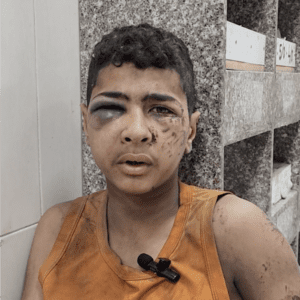
‘I did not think for a moment that I might survive‘
Tawfiq Abu Youssef, an 11-year-old child, sits in Nasser Hospital in Khan Younis where he was referred to for treatment. His face is bloodied and his eyes are swollen blue after he was pulled from under the rubble of their home in Nuseirat. He says he doesn’t know how he escaped death.
“Suddenly, the situation in the area changed, and people started running in fear, saying that special forces had stormed the area,” the boy recounted to Mondoweiss. “All of this was happening in front of our house, and we were stuck inside under fire and bombing. We tried to get out, but drones opened fire on us until the house was bombed and fell over our heads.”
“Before our house was bombed, we saw people in the street across from our house on the ground cut up. We saw missiles hitting the people fleeing in the streets, how they cut them off, and how the planes bombed everything moving in the streets – cars and people. The street was full of people, and suddenly, all of them… They were on the ground, and smoke and blood filled the place. Everywhere we looked, shelling and shrapnel were flying.”
As Tawfiq leaned his back against the hospital wall and sat on the floor to receive treatment, he said that he did not expect to survive this massacre. The scenes he saw were too difficult to believe.
“I stayed under the rubble for hours. I did not think for a moment that I might survive and see life again. I had lived through death enough while I was under the rubble. That was death. I do not think I will forget or get over these moments.”
The operation was carried out near a central market, where Amjad Abu Laban, 43, was selling some food items on the road. He survived death but suffered various injuries to his hand and foot.
He says that everything started at once: planes, tanks, shooting, and people were in the middle of bombing and death and did not know how to react or where to turn.
“Intense bombardment began in several areas in front of us, around us, and behind us, and people began falling to the ground by the dozens near Al-Awda Hospital in the Nuseirat camp. Before our eyes, we saw bodies being torn apart and scattered on the roads, and we saw soldiers hidden in civilian clothes and in people’s cars running and killing everyone they met on their way without distinguishing between a child, a woman, a young person, or an old person. We saw the bodies of our brothers cut up, without heads, lying on the ground,” Abu Laban told Mondoweiss.
“These massacres that occurred before my eyes cannot be described.”
In the same hospital, Mahmoud Al-Hawar, 27, lies on his back as a result of an injury to his leg. Al-Hawar witnessed the massacre as he bravely attempted to save his family and neighbors from the bombing.
“The planes bombed our neighbors’ house, and there was a girl under the rubble screaming to be saved. I went with my friends to try to save her, but the rubble was heavy, and we could not dig her out or even lift it to reach that girl, so we waited until the civil defense team arrived. A large number of young men gathered to try to rescue them. But the planes bombed us,” he told Mondoweiss.
Al-Hawar recounted that he felt the missile hit him and his group of friends and they were thrown to the ground. Minutes later, Mahmoud regained consciousness and found himself covered in blood and saw his friends next to him, on the verge of death.
“Before we were bombed, if I told you that I saw more than 10 drones above our heads, you would not believe it. We were looking at the sky and did not know what was happening.”
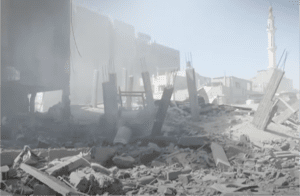
After the bombing, Al-Hawar tried to stand up to save himself and his friends. “I tried to stand up, but I couldn’t. I was covered in blood. I looked at my leg and it was cut off. I looked at my best friend next to me, and I found him taking his last breath.”
Their injuries were all severe, and when someone arrived who could take them to the hospital, the five friends were placed on top of each other in a small transport truck, with Al-Hawar underneath them all.
“I was in pain from my injury, but I was feeling more pain because I could hear my friends pronouncing their martyrdom and taking their last breaths. All my friends were dying above me, and I was hearing and feeling everything. They were all killed. Some of them were martyred on the road before my eyes, and some of them died later.”
Al-Hawar agreed that the scenes he saw of the dead in the streets will never be forgotten. “I have not slept since the incident. I cannot sleep. I cannot forget anything I witnessed and saw. I cannot forget the people who were running in panic and fear, searching for their relatives and families amidst the destruction and dismembered bodies.”
Rescue operations
Rescue teams worked for hours in Nuseirat with limited capabilities in an attempt to recover the bodies that remained under the rubble. Many residents remained missing long afterwards due to the massive bombing in the area, and the many homes that were demolished, some on top of their residents. Many others were killed in the market as they tried to meet the needs of their families.
Anees Ghanima, an activist in the Nusreiat refugee camp, summarized the senseless killing on social media, “This is what happens when we say that we are at risk of being killed at any moment. Imagine that most of those who just left were only in the market, trying to meet their families’ needs. Put yourself in the place of the child who spent all night deceiving his mother to buy him some necessities, and she was killed today during raids. How could we tell him about peace in this world?”
Hassan Sleieh contributed to this report.Tareq S. Hajjaj is the Mondoweiss Gaza Correspondent, and a member of the Palestinian Writers Union.
RELATED READING:

